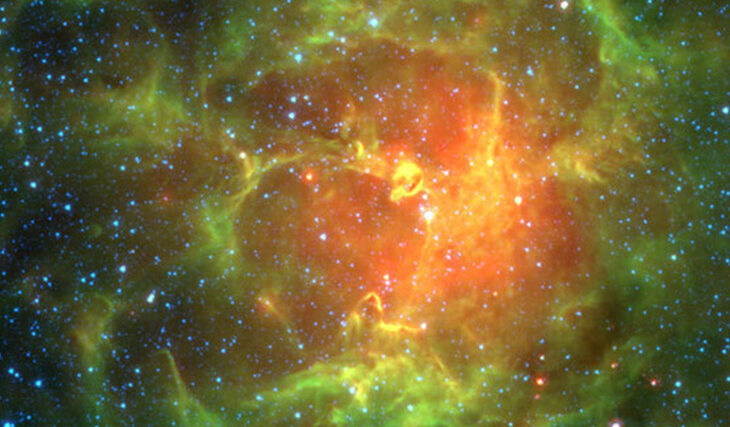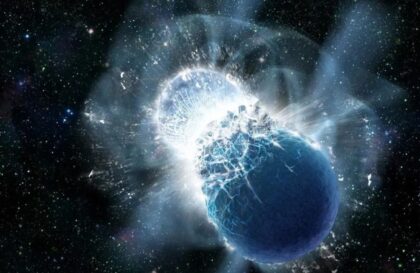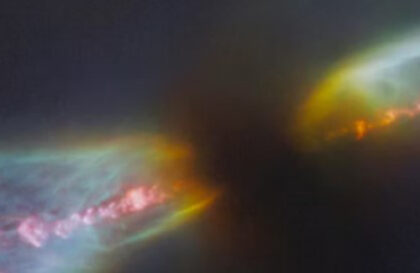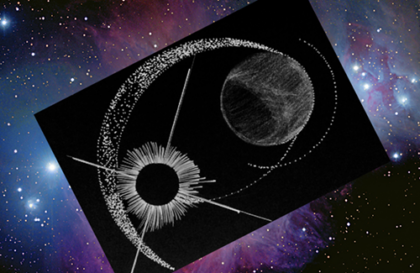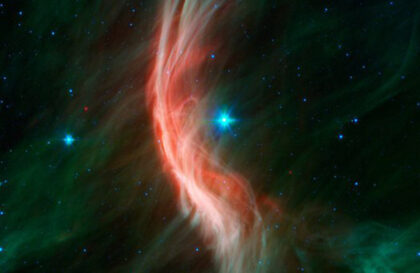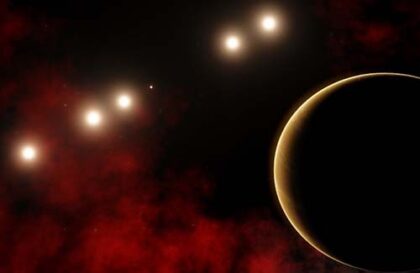Oddly enough, but no one knows for sure how stars are formed. We don’t know for sure when the very first stars appeared.
We know that the oldest stars in our galaxy are about 11 to 13 billion years old. Accordingly, the Milky Way is about the same time, but we also know little about its formation.
Until 1930, the dominant view was that stars were no longer born because there was no hydrogen in outer space. It exists only in existing stars.
Star birth patterns
Champagne model
In interstellar clouds, a constant struggle develops between two contradictory tendencies: contraction and expansion. Clouds contract under the influence of their own gravity and external forces, such as the explosions of nearby stars, while the pressure of gas and magnetic fields within the cloud pushes it apart. Usually, compression forces predominate. Starlight does not penetrate or heat opaque clouds, while infrared radiation from molecules and dust can escape and carry away heat, causing the temperature in the dense part of the cloud to drop to near absolute zero (-270°C). This upsets the balance of forces, and the area begins to shrink.
If the mass of the compressed gas is small, then a single star is formed. In the case of a large mass of gas, it can compress and fragment, giving rise to a group of objects, including stars. This theoretical model of the “birth” of young stars from interstellar clouds is called the “champagne model”.
The dark cloud, whose silhouette is clearly visible against the background of the Milky Way, plays here the role of an impenetrable bottle, inside which newborn stars heat up the surrounding gas and raise its pressure. In the end, the cloud breaks down, its thinnest wall (“cork”) breaks through, and a jet of hot gas shoots out into the surrounding space.
This is the moment we see in the photo. The bright nebula at the center of the cloud is hot gas that escaped at about 10 km/s and rushed towards the sun. Sleep well – it will never reach the solar system.
The black hole model
Supermassive black holes are hidden in the cores of many galaxies. They actively absorb the surrounding matter, heating it up and throwing out significant volumes of gas “wind” into the surrounding space.
Professor Roberto Maiolino from the University of Cambridge conducted a study that unequivocally confirmed that star formation is indeed taking place inside the matter ejections from black holes. The rate of star formation in these ejecta was very high: astronomers estimate that approximately 30 solar masses are formed here every year, which is more than a quarter of the total star formation in the galactic systems that underwent a collision.
The birth of a star?
In the process of formation, each star goes through two characteristic stages – fast and slow contraction of the protostar.
Fast compression
this is the phase when the matter of the protostar falls almost freely towards its center, and gravity plays a major role. Despite the expected heating of the gas during compression, its temperature remains almost unchanged. The excess heat is released in the form of infrared radiation, which freely passes through the loose protostar, since it is practically transparent to this type of radiation. This stage lasts about 100 thousand years, during which the size of the protostar is reduced by many orders of magnitude – by 100 thousand times, and the density of matter inside it increases by millions of billions of times – from almost complete vacuum to the density of room air.
Slow compression
And now the protostar reaches the moment when it becomes opaque to its own infrared radiation. This leads to a sharp decrease in heat removal, and as the gas continues to be compressed, it rapidly heats up. The increased pressure begins to balance the force of gravity, and now the protostar can only shrink at a rate that the slow cooling of its surface allows.
This stage lasts several tens of millions of years, but during this time the size of the future star decreases only ten times, and the density of matter shrinks to about the density of water. Interestingly, the density in the center of the Sun reaches 100 g/cm³, which is 13 times higher than the density of iron, and the average density of the Sun (1.4 g/cm3) is equal to the density of water in the Dead Sea. Nevertheless, the solar matter remains in the state of gas, or rather, plasma.
When the temperature inside the protostar reaches several million degrees, thermonuclear reactions begin, as a result of which hydrogen is converted into helium with the release of heat. This heat compensates for heat loss from the surface, and the compression stops. The protostar becomes a real star.
What is the rate of star formation?
So far, not a single object has been discovered that can be said with certainty that it is a collapsing protostar. The rate of star formation is unknown. Probably tens of millions of years.
But the established fact is the “cuckoo” star.
When a massive luminary appears in a group of young stars, it begins to play a dominant role: its intense radiation and gas emissions from the surface (stellar wind) heat up the surrounding matter, stopping the compression process and stopping the formation of new stars. This massive luminary is clearing its space like a cuckoo in a nest.
Sometimes the activity of massive stars not only stops star formation, but can also lead to the destruction of an entire young cluster of stars. Together with interstellar gas, the cluster loses a significant part of its mass, which makes young stars more mobile and able to leave their “birthplace” under the influence of weakened gravity.
Why is it difficult to see how stars form?
Stars are born in deep and cold clouds of gas and dust that are completely opaque to light. Most of these clouds, about 98%, are made up of light elements such as hydrogen (in the form of H2 atoms and molecules) and helium, which hardly interact with light and do not interfere with its passage. However, the remaining 2% of the cloud mass, containing heavier elements, contains tiny solid particles only a fraction of a micron in size – microscopic dust that actively absorbs and scatters light radiation. Trying to observe the process of star formation through this “fog” of dust and gas is an extremely difficult task.
In addition, molecular hydrogen, which makes up the bulk of the molecular clouds from which stars are born, emits virtually no light and remains invisible to observers on Earth. We can only see the contours and shadows of these clouds, indicated by the radiation of other substances in them, and to fully understand the process of star formation, we have to take into account their composition relative to molecular hydrogen.
How do stars die?
It has been established how long the stars live and how their life ends.
The luminosity and lifespan of stars are closely related to their mass. Stars come in different masses, and this mass determines how brightly they shine and how long they live. Stars similar to the Sun, with a mass of about 1 solar mass, have an expected lifetime of about 10 billion years. While giant stars, ten times more massive than the Sun, burn out completely in just 25 million years. On the contrary, dwarf stars with a mass of half the mass of the Sun can live for more than 100 billion years, which exceeds the age of the universe.
Ultimately, at the end of its life cycle, the star usually sheds the top layer of its material. Massive stars do this explosively, going supernovae, while less massive stars quietly shed their outer layers and surround themselves with a slowly expanding planetary nebula. As a result, after this stage, an expanding gas cloud and a compact object inside it remain from the star, which can be a white dwarf, a neutron star, or a black hole.
Image credit:
https://www.universetoday.com
https://www.eso.org
https://www.nasa.gov
https://www.sciencefocus.com
